Jame Abbasi Mosque (Shah Mosque)
Throughout the history, each dynasty has tried to show its glory and diminish the role of its previous dynasties. That said, Shah Abbas was no exception either. After declaring Isfahan as his capital in 1597, Shah Abbas the Great tried to make changes to the city’s structure and build a center according to Safavid origins. Therefore, in addition to Naqsh-e Jahan Square, he ordered the construction of the Shah Mosque as the religious center of his capital at that time. The construction of the Abbasi Great Mosque (Shah Mosque) began in 1611 and it took almost 18 years to be completed. Shah Abbas wanted all the plans and designs to be done as quickly as possible. Accordingly, he firstly ordered that the entrance and the gate of the mosque to be built. In this way, he was aiming to maintain the glory of the square in the best way. As for the mosque itself, it is a four-iwan (Porch) mosque and has a Shabestan (Prayer room) in its eastern part, which is often used during winter. The Naseri School (attributed to Nasser al-Din Shah Qajar for its reformations) and the Sulaimaniyah School (attributed to Shah Suleiman the Safavid) are located on the eastern and western sides of the south iwan. Actually, these two schools are theological schools where religious studies were taught to Tollabs (theology students). Several rooms in these schools were used as their accommodation.
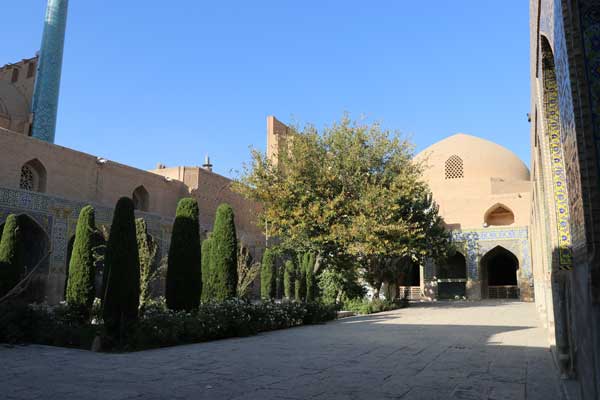
Madrasa Naseriyeh inside Abbasi Great Mosque
The entrance to the spiritual world
Upon entering the Abbasi Great Mosque(Shah Mosque), one faces a gate that is covered with beautiful and eye-catching Moqelli tile wroks. One must raise their head to the sky to see the whole beauty of the entrance and the gate. Two Minarets with a height of 42 meters protect both sides of the gate and give it a special strength. The main entrance is through the same doors that were made from silver during the reign of Shah Sultan Hussein. Unlike Sheikh Lotfollah Mosque, the entrance of the Abbasi Jameh Mosque is decorated with Moqelli tiles and the inside of the mosque is decorated with seven-color tiles. The calligraphies used for Quranic verses around this mosque are mostly the masterpieces of Alireza Abbasi and his famous followers Abdolbaqi Tabrizi and Mohammad Reza Emami.
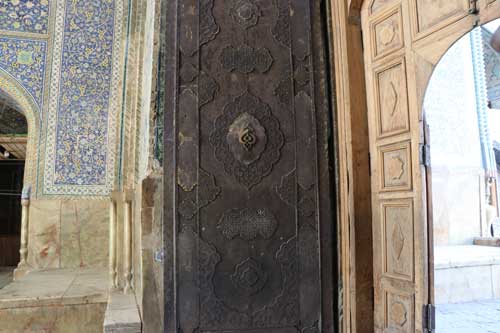
Shah Mosque Entrance
Destroying the rules of funding
Right at the entrance of the mosque, on the west wall, we can see a verse which is much respected by the Muslim. This verse is usually recited by the Muslims before doing anything. The verse is ‘’ bismillah ar-rahman ar-raheem’’ which translates as ‘’in the name of God’’. Below this verse, there is a stone carving that was done by a kind of ax. This carving dates back to the time of Nader Shah Afshar. This carved inscription apparently contained the orders of funding and income expenses of the Abbasi Jameh Mosque. There is a story that when Nader Shah entered Naqsh-e Jahan Square after claiming Isfahan back from the Afghans, a question came to his mind. He thought to himself, if the income of the mosque was spent on the government and religion for the people, why is there neither any religion nor government left for the Iranian nation. For this reason, he resented the mullahs’ actions and dumped the portable inscriptions in the Zayandeh River. As for the others, he ordered that all the inscriptions on the west wall of the mosque’s entrance be carved and send out in the favor of the government.

Inscriptions on the west wall
Quenching the thirst of the worshipers with Sangab
The Sangab (stone monuments) placed inside the mosque were all for drinking water. It should be mentioned that some say that they were used for ablution (washing the face and hands before saying prayers). However, it should be noted that ablution water was accessible through the water that was brought to the square through the canals and was poured into the pool. In the past, especially in Iran, drinking water could not be easily found. The water was only accessible through a special process. Accordingly, Sangab was used as a way of providing drinking water for the people. Often, there are poems about the third Imam of Shia, Imam Hussein, on the body of Sangab in Nastalik calligraphy. It should be noted that Imam Hossein and his family were killed by in an unjust battle. The enemy made them die of thirst while there was a river just near the battle ground. Since then, especially from the Safavid era, water have had a symbolic and spiritual meaning for Shia Muslims.
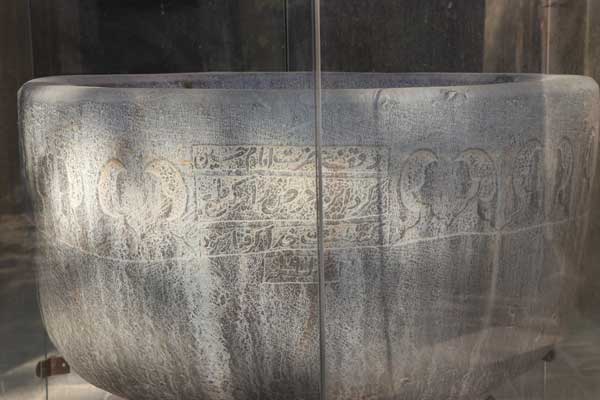
Stone monuments inside Shah Mosque
Inside the Shah Mosque
While passing through the main gate and entering the mosque, the visitors, without noticing, are turning towards the Qibla. This change of angle without one’s notice shows the skill of the architect. Accordingly, the dome of the Abbasi Jameh Mosque has an eye-catching Iwan (Porch). Plus, there are two 48-meter-high minarets in front of this 52-meter-high dome. During the first and second Pahlavi eras, the Abbasi Jameh Mosque was in a bad condition and the whole south iwan with its minarets were collapsing. The government rushed to rescue this national monument by inviting the great French architect, Andre Godard. The iwan was then connected to the hillock of the dome. For this to be done, some iron chains were used to tie the minarets to the dome.
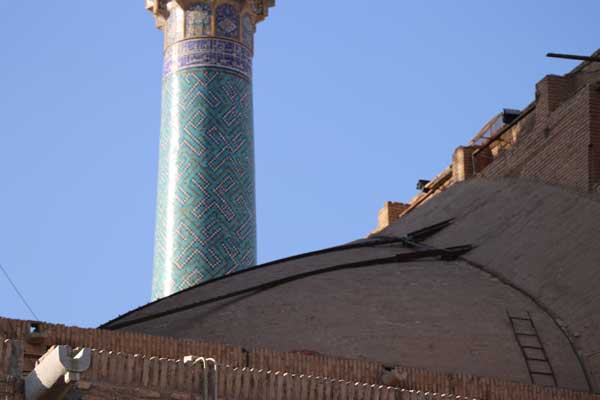
The minarets are tied to the dome
There is a smaller minaret above the west iwan. The servants of the royal court and the harem, after noticing that the taller minarets had view to the harem, asked the muezzin (a man who calls Muslims to prayer) of the Abbasi Jameh Mosque to use this smaller minaret to call for prayer.

Shah Mosque’s small minaret above the west iwan
In Sulaimaniyah School, a piece of stone is designed in the shape of a triangle. Its design is attributed to Sheikh Baha’i, the master architect of the Safavid era. This piece of stone was used to accurately calculate the time of the day for prayer and especially at noon.

The piece of stone that shows prayer time at noon
The main Courtyard of Abbasi Great Mosque
In the main courtyard of the mosque, a 14-step Menbar (pulpit) made of marble can be seen. It is worth mentioning that numbers such as 5, 7, 12, 14 and 40 are symbolic numbers in the Shia Muslim religion. These numbers have been used extensively in the design of buildings and especially mosques. Just above the Mehrab (altar), there is a small space in the heart of the south wall. Jean Chardin (French Traveler) believed that the bloody shirt of the third Shia Imam, Hussein Ibn Ali, along with a Quran written by Imam Reza, the eighth Shia imam, are inside this wall space. The inside of this space was made out of gold. Probably, the gold and the belongings were looted during the Afghan invasion of Isfahan. The main altar of the Abbasi Jameh Mosque is considered as one of the most beautiful altars of the Safavid era. Below this altar, there is a place for prayer, which is a few centimeters below the level of the mosque. This is for showing humility and obedience of the frontier person compared to all the worshipers behind him.
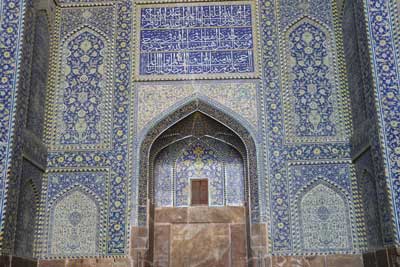
Abbasi Great Mosque Mehrab
The Abbasi Jameh Mosque, which was once a meeting place of Muslims and Shias, still hosts thousands of tourists every year. From all around the world, they set their foot inside to hear the reflection of their voices below this dome in different languages and dialects!
The construction of the Jameh Abbasi Mosque (Shah Mosque) began in 1611 and it took almost 18 years to be completed. Upon entering the Jameh Abbasi Mosque, one faces a gate that is covered with beautiful and eye-catching Moqelli tile wroks. The Naseri School (attributed to Nasser al-Din Shah Qajar for its reformations) and the Sulaimaniyah School (attributed to Shah Suleiman the Safavid) are located on the eastern and western sides of the south iwan. Actually, these two schools are theological schools where religious studies were taught to Tollabs (theology students). Several rooms in these schools were used as their accommodation. The Sangab (stone monuments) placed inside the mosque were all for drinking water. It should be mentioned that some say that they were used for ablution (washing the face and hands before saying prayers)
Abbasi Great Mosque FAQs
Abbasi Great Mosque (Shah Mosque) is open:
Everyday 09:00 – 17:00
(0.9 km) Narcis B&B

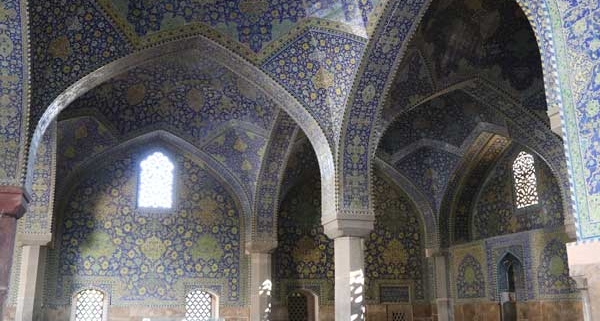
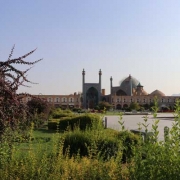
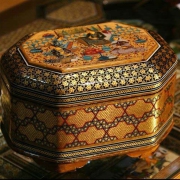
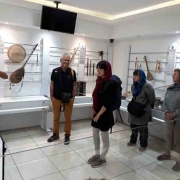
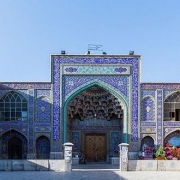

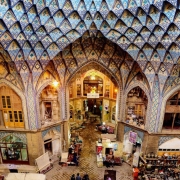
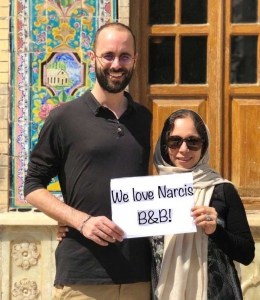




Leave a Reply
Want to join the discussion?Feel free to contribute!